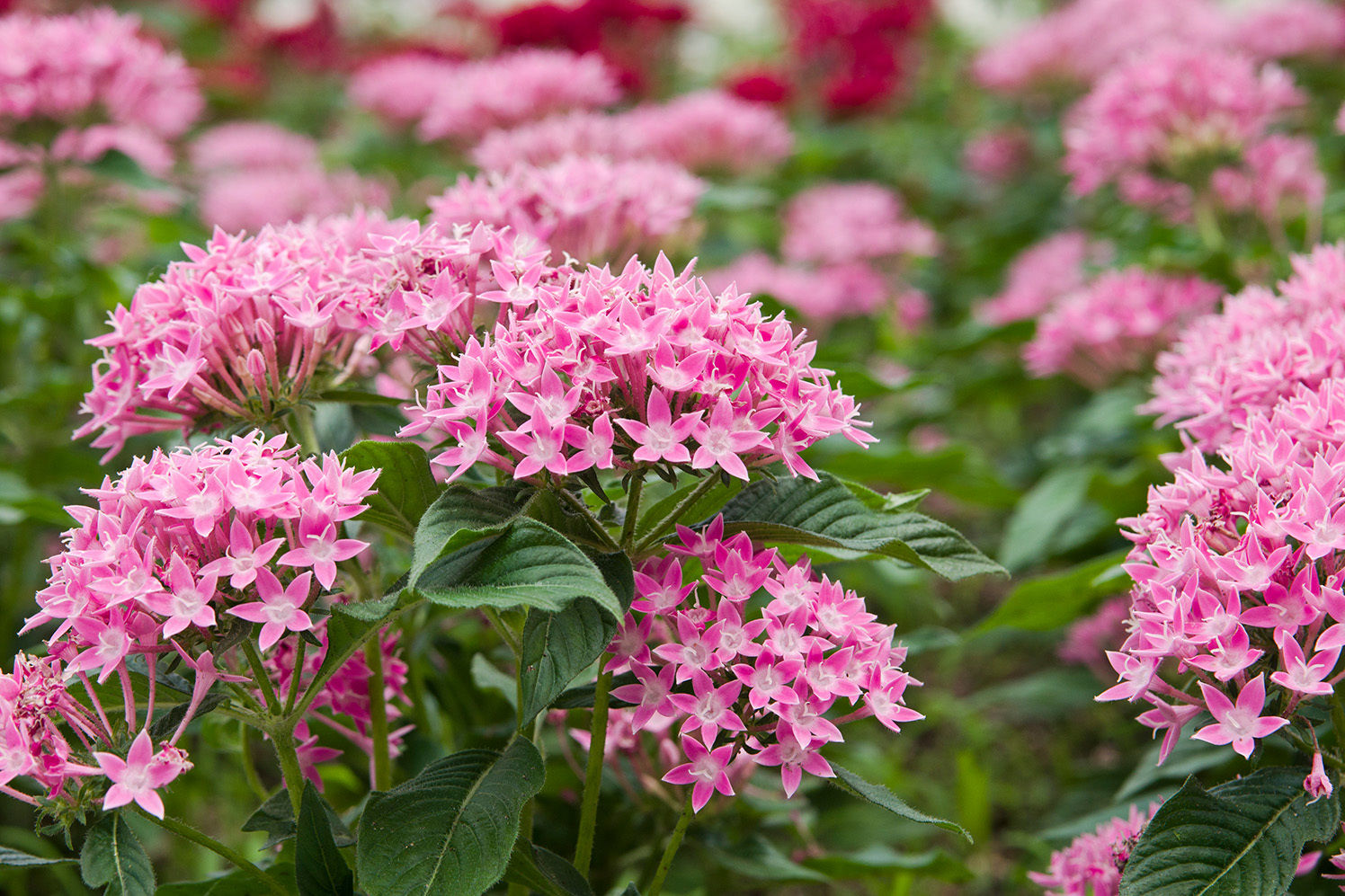Bye-Bye, Lawn: Four Great Alternatives to Grass Landscaping
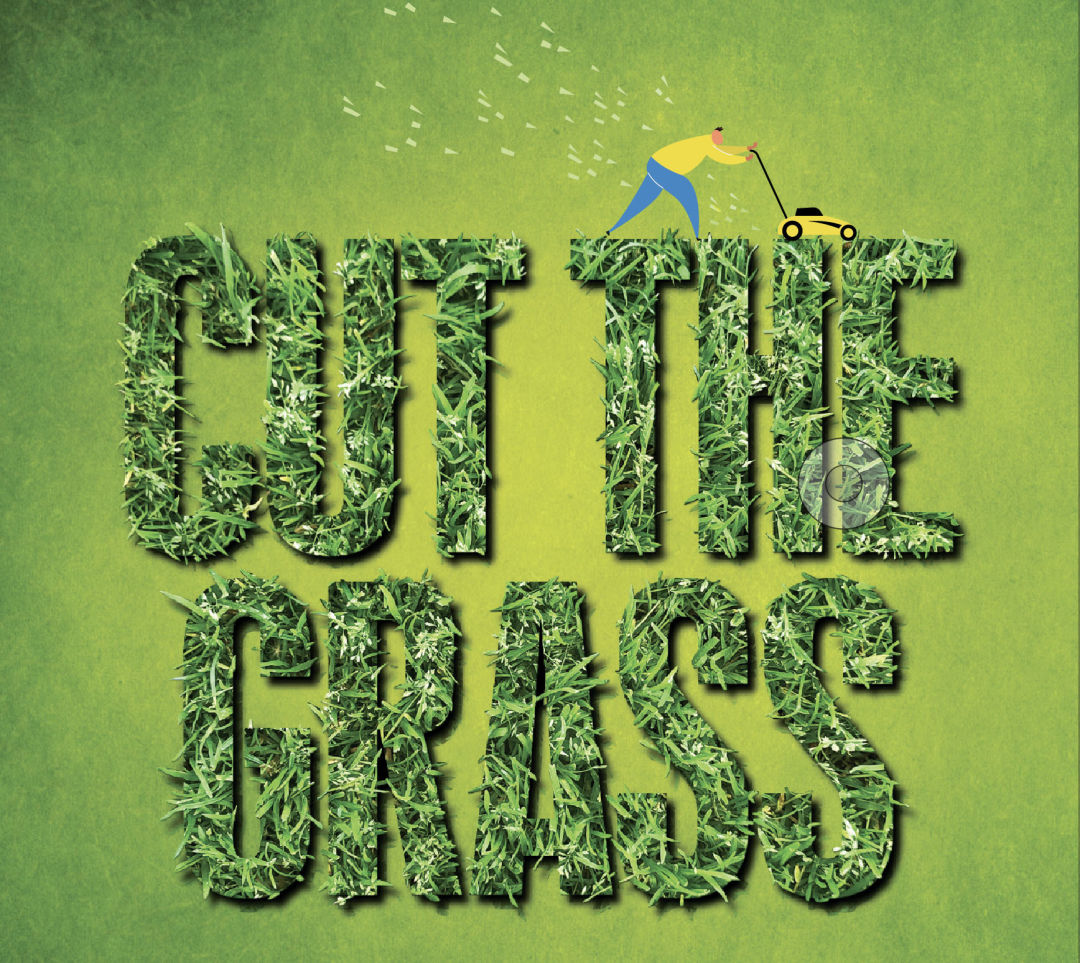
Image: Staff
Ah, the Great American Lawn. Your mental picture probably summons up a perfect lush, green carpet. But turning that cultural status symbol into reality means an endless cycle of mowing, weeding, regular watering, and heavy doses of fertilizer and pesticides. Irrigating with precious water and applying those chemicals are not only hard work; they’re hard on the environment. The good news is, you can still have the best yard on the block. It just doesn’t have to be turf grass. Area experts share four creative alternatives to traditional grass landscaping. They’re all eco-friendly. Done right, they can also be beautiful.
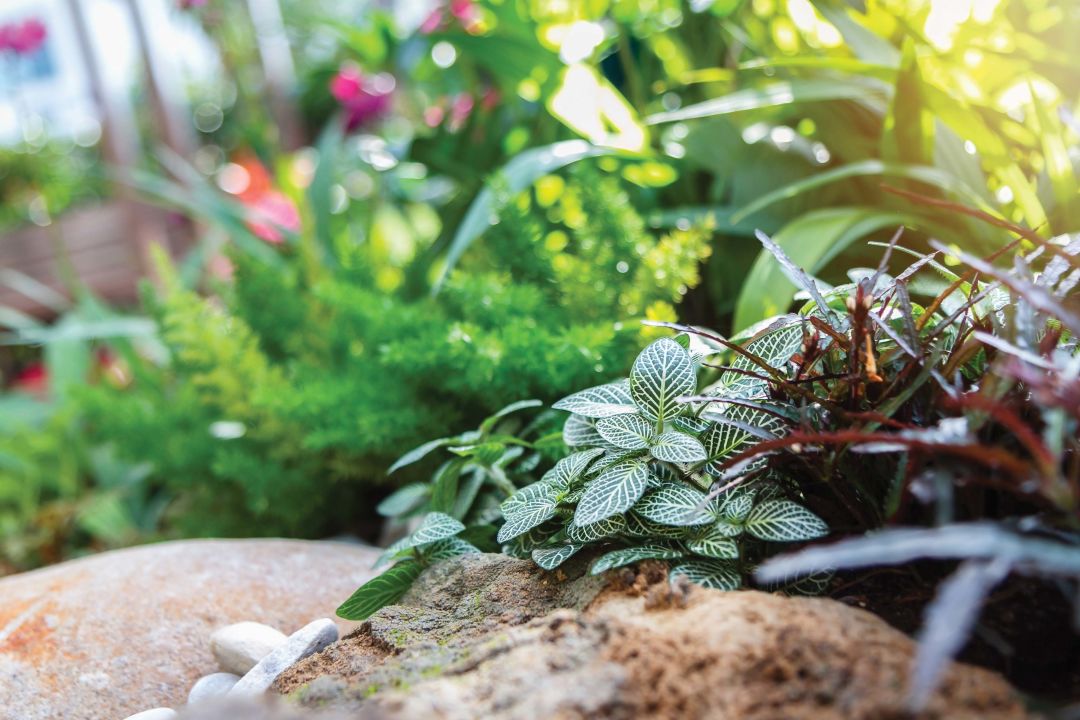
The delicately veined fittonia (foreground) grows to a height of six inches; the bright green foxtail fern (background) is a good border plant.
Image: Shutterstock
Groundcover
In Florida, a turf grass lawn is under constant siege. Blink, and the weeds have taken over. Clinton Lak prefers groundcover. As a landscape architect at ArtisTree, he’s a fan of hardy, low-maintenance grass alternatives. The trick is planting a groundcover that will thrive in your yard.
“There’s no single Florida climate,” Lak explains. “Our region has a wide range of variables, from soil to salinity to alkalinity to available sunlight. A groundcover that thrives on the barrier islands might shrivel east of I-75. You have to do your homework.”
Lak says ferns and flowering plants make good groundcover. Ferns spread out beautifully, and foxtail ferns thrive in sun or shadow. You can also replace grass with Florida native plants sunshine mimosa, perennial peanut and beach sunflower. These plants thrive in sandy soil where grass barely survives. Lak also likes hardy out-of-state upstarts like Japanese sweet flag, Asian star jasmine and creeping herbs like thyme and oregano. For annuals, plant petunias, which offer a splash of color in winter. For perennials, crawling ground-huggers like lantana and blue daze will quickly fill in the gaps.
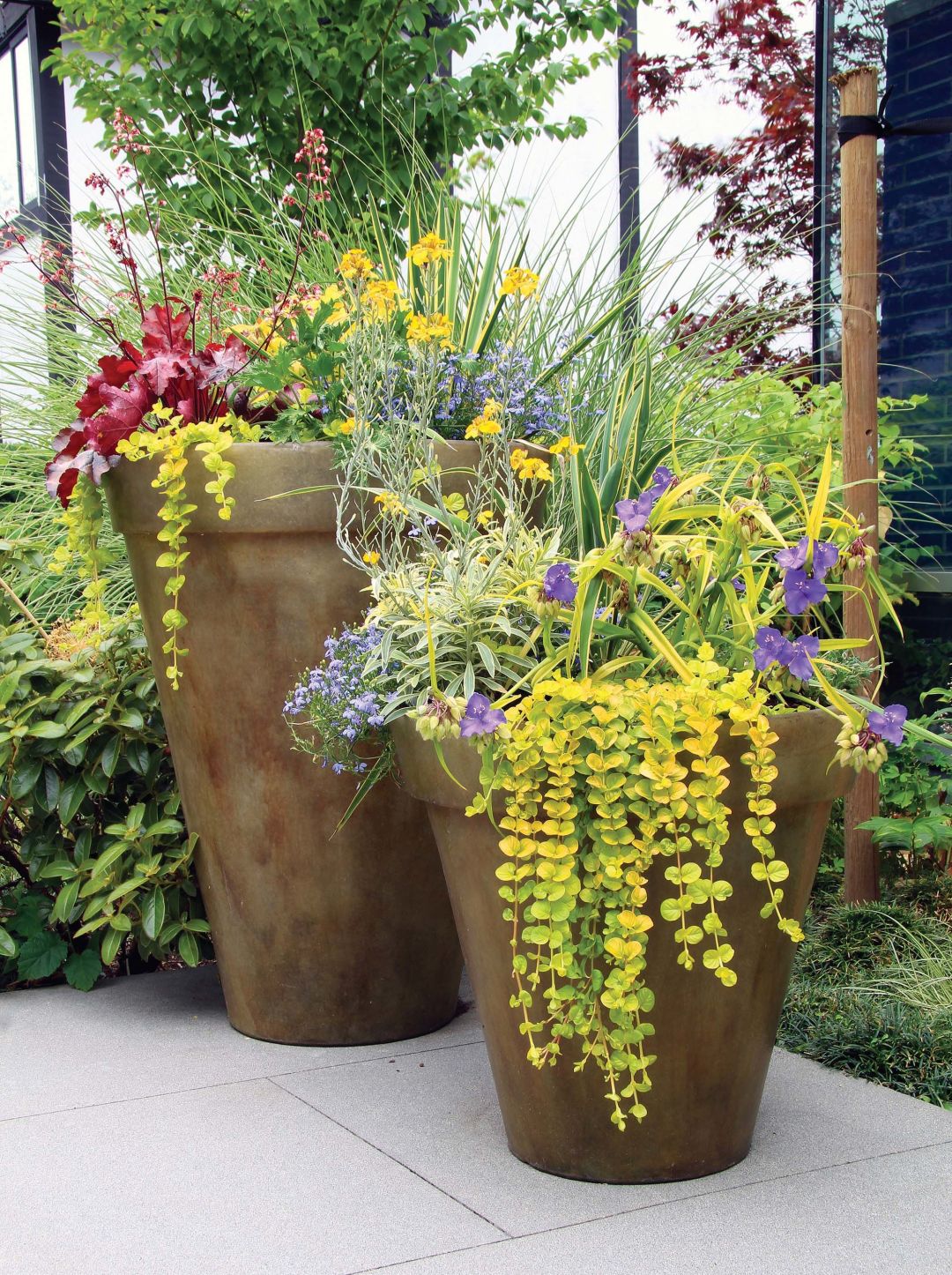
Ceramic pots filled with yellow creeping Jenny, blue spiderwort and variegated grasses.
Image: Shutterstock
Container Gardening
Landscape artist Michael Gilkey is a big fan of container gardening, which refers to growing plants in pots, planters, urns, vessels and boxes, instead of in the ground. Container gardening wastes far less water and doesn’t create runoff that pollutes our bay and Gulf. It’s also beautiful.
“I’m fond of a concept called ‘show and flow,’” he says. “A taller plant like a bromeliad in the middle creates structure. Then you surround it with another plant that cascades around the rim. Flowering plants like salvia are great candidates. Muhly grass and other Florida-native grasses are quite beautiful.”
Container plantings spice up a grand landscape with accents of color and beauty. In a small lot, they can be the whole show. “You’d be surprised how much you can grow in a 12-foot-by-12-foot area,” Gilkey says.
Gilkey uses succulents such as kalanchoes, aloes, cacti and other desert flora that combine good looks with low maintenance since they’re drought-resistant. Flowering plants such as the pretty Cape Daisy, which comes in a variety of colors, and blue daze and trailing lantana are other colorful container candidates.
For nonflowering foliage try the spiky-looking devil’s backbone or the Persian shield with its iridescent purple leaves.
Small trees like the lady palm can also thrive in large pots and provide variety in height.
And don’t forget that herbs and edibles flourish in containers: parsley, thyme, cilantro and Everglades tomatoes provide greenery and groceries.
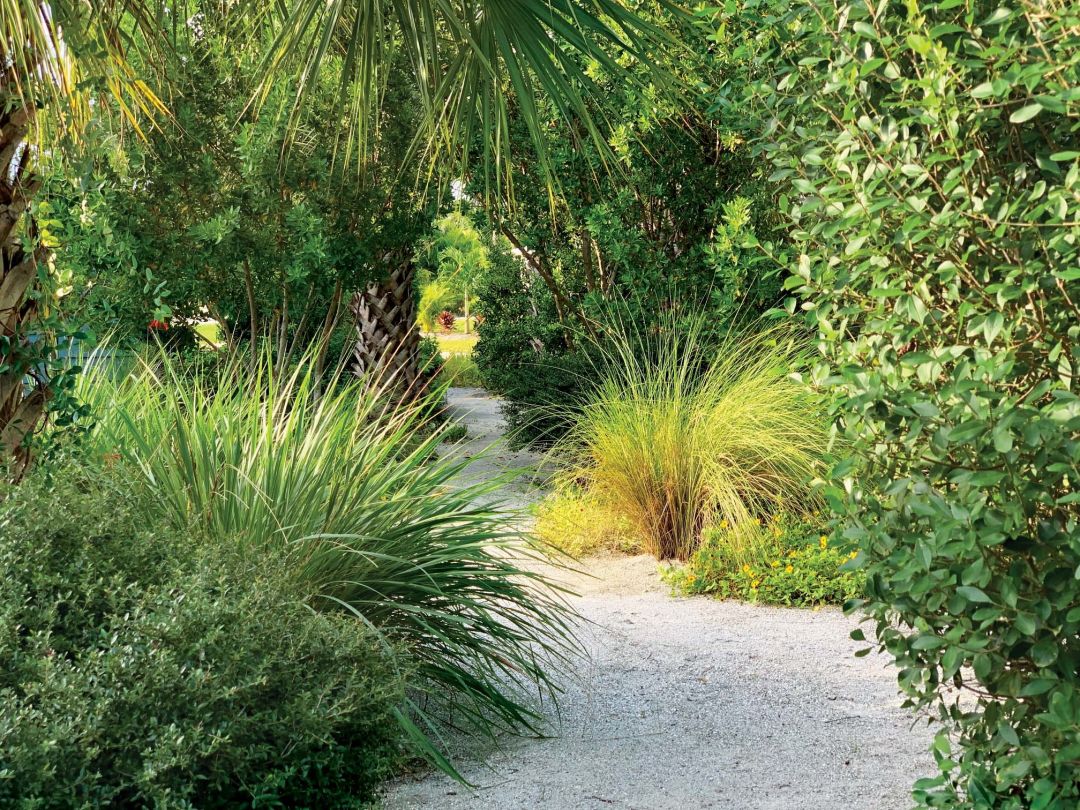
An eco-friendly path of made of local 250 Sand.
Image: Gigi Ortwein
Hardscaping
Replace grass with walking paths made of shell, crushed granite, glass, lava rock, river rock, and natural stone pavers—all eco-friendly and functional architectural features.
“High porosity pavers are great in heavily trafficked areas; water can go back in the soil instead of washing out,” says Robert Davie of Robert Davie & Associates Landscape Design. Natural stone pavers like travertine and Philippine sandstone are good hardscaping materials. “Shell Lock has a fantastic line of shell-embedded pavers, perfect for courtyards and paths near beach homes and the new generation of modernist architecture.”
Davie also likes the flexibility of pavers. “Let’s say there’s an issue with tree roots or buried utilities,” he says. “If the problem’s under concrete, you have to rip it out, and that’s a pain. But pavers make it easy. Just take out a few pavers, fix the problem, then put them back in the exact same place.”
And for those who don’t mind a little sand between their toes, sand paths, or entire sand yards with paver paths, are porous, eco-friendly and replicate our original coastal environment. Anna Maria landscape designer Michael Miller has been using 250 Sand—a specific mix of shell and sand from local mines—for decades on residential and commercial properties on the barrier islands. 250 Sand is inexpensive, self-compacting (so it doesn’t wash away) and allows for perfect drainage. And about those sandy feet? A strategically placed spigot near a doorway or natural fiber doormats will do the trick.
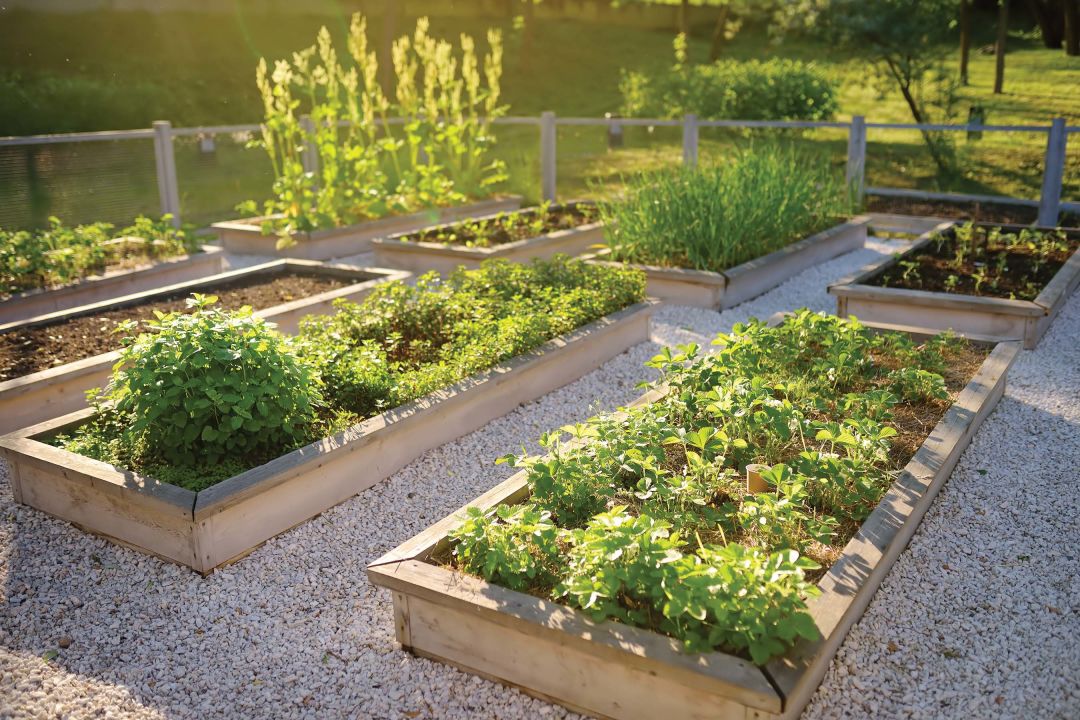
Edibles in raised beds grow best from October through March.
Image: Shutterstock
Edible Gardens
Debbi Benedict has a green thumb, and her yard is proof. Her quarter-acre yard flourishes with more than 100 fruit trees, shrubs and vines, and a countless variety of native flowering plants. She calls it “Benhaven Farm.” “It’s my edible landscape,” she says. “Food for myself, the birds, bees and butterflies and, most importantly, for my soul.”
To create her garden, Benedict got rid of most of the grass and instead has two feet of mulch on top of the soil with shell paths running through the property. She installed a drip irrigation system to keep everything watered.
“If you have the right soil, the right light conditions, and the right water amount, everything is pretty easy to grow,” says Benedict. For beginners, she recommends starting with mulberry, papaya, carambola, Barbados cherry and mango. Remember that fruit trees take up to five years or more to grow large enough to produce a decent crop.
Want to see this slice of paradise up close? Benhaven Farm will have its first open house on Nov. 1 and 2. Visit debbibenedict.com.
Benhaven Farm’s Edible All-Stars
Trees: Persian lime, Myers lemon, ice cream bean, peanut butter fruit, wax jambu, strawberry and black sapote.
Spices: bay leaf, allspice, cinnamon and stone fruit.
Herbs and mints: rosemary, fennel, dill, parsley, sage and basil.
Classic garden vegetables: tomatoes, peppers, chard and a host of lettuces.
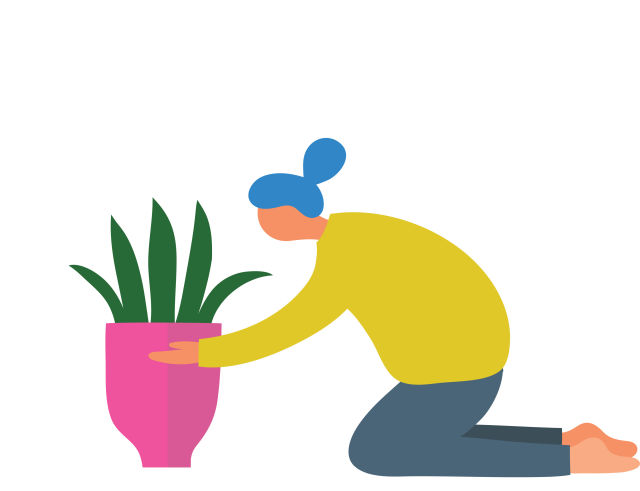
Image: Shutterstock
Seeds of Knowledge
Before you rip out the grass and sell your lawn mower, know what you’re doing. Fortunately, the horticultural gurus at Sarasota County’s UF/IFAS Extension can help with Florida- friendly landscaping. Pat Williams oversees the program. Water wisdom is the first lesson.
“That means conserving water by using efficient arrangements of native, drought-resistant plants,” he says. “The practice originated in the American Southwest, but it’s not limited to arid landscapes. We offer a regional application of xeriscaping principles. It doesn’t have to mean [a lawn of] rocks and shells. A xeriscape lawn can be as lush as a Rousseau painting.”
The second lesson? “Right plant; right place.” Sunlight and soil conditions on the one hand, and a grasp of which plants flourish under those circumstances on the other. You can find a trove of information on the UF/IFAS Master Gardener program website.
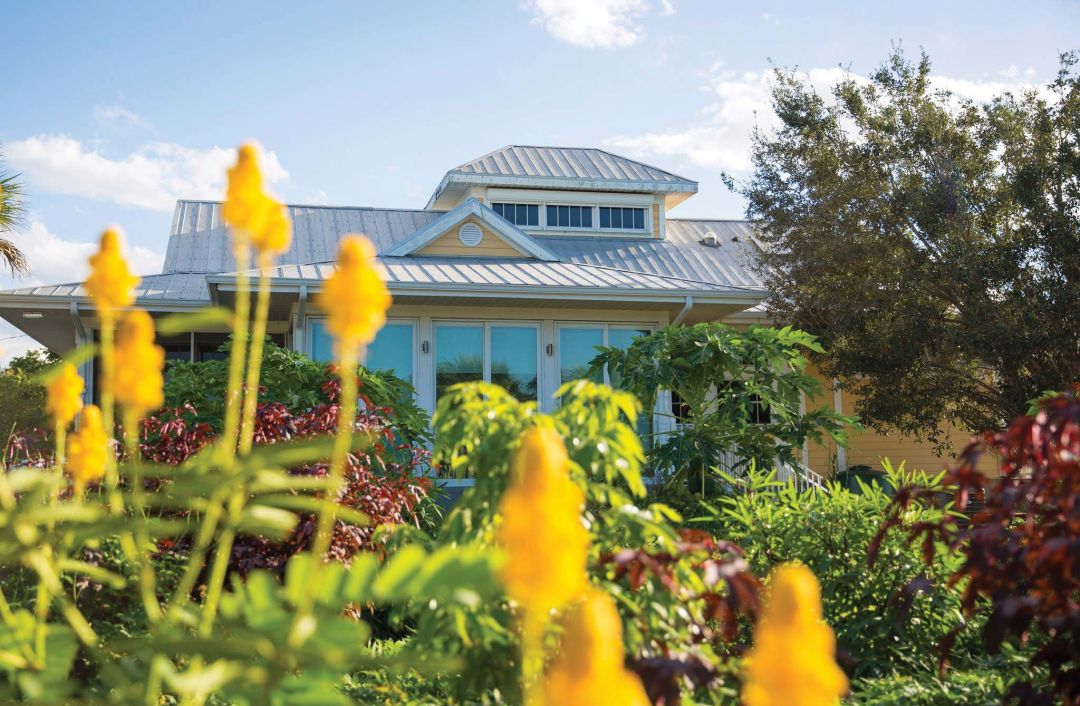
The Florida House
Image: Courtesy Photo
A Model Yard
For real-world examples of grass-free lawns, take a drive to the nonprofit Florida House Institute in Sarasota, which showcases container gardening, edible gardening and alternate groundcovers. The yard demonstrates the use of hardy, Florida-natives and intelligent water conservation. It also shows how contouring the land with bioswales traps rainwater and filters run-off before it reaches the aquifer.
Diane Keel, Florida House Institute’s urban agriculture and landscape manager, says, “No single approach works for everybody. But there’s a sustainable model that works for you. If you come here, you can see for yourself. And by all means copy us. If we can grow it, so can you.”

Image: Shutterstock
Turf Wars
Which is more eco-friendly in Florida? A living lawn that requires lots of water and chemicals, or artificial turf that requires no watering or fertilizing, but is made from plastic? The jury’s still out, but technology is making artificial grass a more acceptable option.
“It’s not your granddad’s AstroTurf,” says Ed Wooster of Eco Turf. “The new materials are stronger, more resilient, pet-friendly and kid-friendly. You’re not using water, and your fertilizers aren’t running off in the ground water.”
Wooster adds that cleanup is easy. “We get so much rain in Florida, Mother Nature usually washes it off for you. In a drought, just hose it down and you’re good to go.”
Wooster adds that artificial turf is also good for ears and air. “Eliminating lawn mowers cuts down on noise and air pollution,” he says.
Steve Nielsen, a landscape designer and president of Critter Ridge Landscaping Company, says we shouldn’t demonize turf grass, which is a porous groundcover that helps to cool the environment and is good for some beneficial insects, too. Just keep grass to a minimum.
“I think grass has gotten a bad rap,” he says. “Grass is a great filter, and it makes for a beautiful lawn with proper care. I think the problem isn’t grass itself, but how we deal with it. People tend to overkill when it comes to water, fertilizer and chemicals. But turf is OK, if it’s used in a responsible way. It’s all about using the right grass in the right area.”



